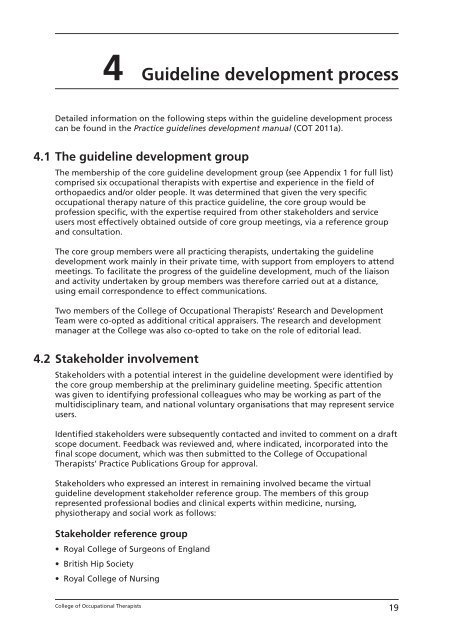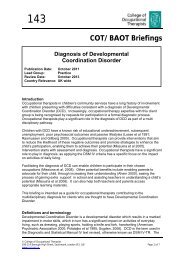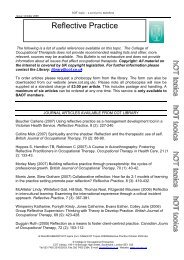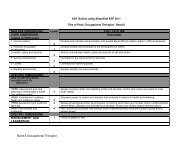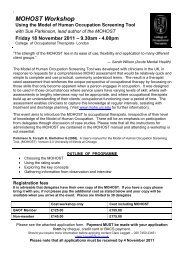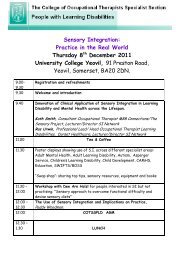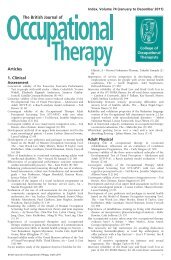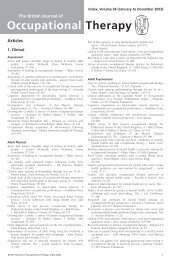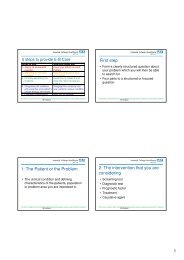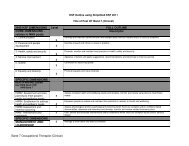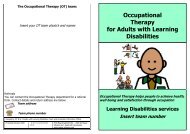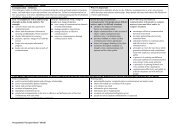Total hip replacement - College of Occupational Therapists
Total hip replacement - College of Occupational Therapists
Total hip replacement - College of Occupational Therapists
You also want an ePaper? Increase the reach of your titles
YUMPU automatically turns print PDFs into web optimized ePapers that Google loves.
4 Guideline development process<br />
Detailed information on the following steps within the guideline development process<br />
can be found in the Practice guidelines development manual (COT 2011a).<br />
4.1 The guideline development group<br />
The members<strong>hip</strong> <strong>of</strong> the core guideline development group (see Appendix 1 for full list)<br />
comprised six occupational therapists with expertise and experience in the field <strong>of</strong><br />
orthopaedics and/or older people. It was determined that given the very specific<br />
occupational therapy nature <strong>of</strong> this practice guideline, the core group would be<br />
pr<strong>of</strong>ession specific, with the expertise required from other stakeholders and service<br />
users most effectively obtained outside <strong>of</strong> core group meetings, via a reference group<br />
and consultation.<br />
The core group members were all practicing therapists, undertaking the guideline<br />
development work mainly in their private time, with support from employers to attend<br />
meetings. To facilitate the progress <strong>of</strong> the guideline development, much <strong>of</strong> the liaison<br />
and activity undertaken by group members was therefore carried out at a distance,<br />
using email correspondence to effect communications.<br />
Two members <strong>of</strong> the <strong>College</strong> <strong>of</strong> <strong>Occupational</strong> <strong>Therapists</strong>’ Research and Development<br />
Team were co- opted as additional critical appraisers. The research and development<br />
manager at the <strong>College</strong> was also co- opted to take on the role <strong>of</strong> editorial lead.<br />
4.2 Stakeholder involvement<br />
Stakeholders with a potential interest in the guideline development were identified by<br />
the core group members<strong>hip</strong> at the preliminary guideline meeting. Specific attention<br />
was given to identifying pr<strong>of</strong>essional colleagues who may be working as part <strong>of</strong> the<br />
multidisciplinary team, and national voluntary organisations that may represent service<br />
users.<br />
Identified stakeholders were subsequently contacted and invited to comment on a draft<br />
scope document. Feedback was reviewed and, where indicated, incorporated into the<br />
final scope document, which was then submitted to the <strong>College</strong> <strong>of</strong> <strong>Occupational</strong><br />
<strong>Therapists</strong>’ Practice Publications Group for approval.<br />
Stakeholders who expressed an interest in remaining involved became the virtual<br />
guideline development stakeholder reference group. The members <strong>of</strong> this group<br />
represented pr<strong>of</strong>essional bodies and clinical experts within medicine, nursing,<br />
physiotherapy and social work as follows:<br />
Stakeholder reference group<br />
• Royal <strong>College</strong> <strong>of</strong> Surgeons <strong>of</strong> England<br />
• British Hip Society<br />
• Royal <strong>College</strong> <strong>of</strong> Nursing<br />
<strong>College</strong> <strong>of</strong> <strong>Occupational</strong> <strong>Therapists</strong><br />
19


